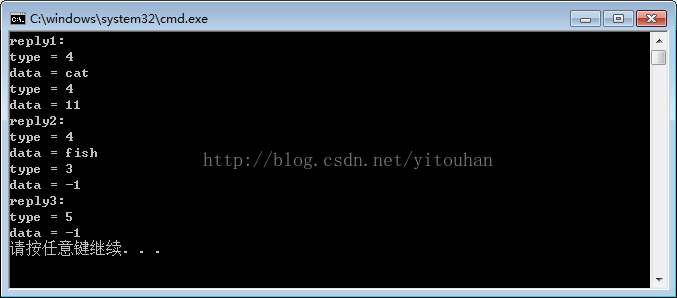redis client protocol 实现
在官网中http://redis.io/clients有许多已经实现好的redis client;有需要可以参考一下。
其实前一篇http://blog.csdn.net/yitouhan/article/details/46612925 redis client protocol 解析,我已经对RESP做主要的解析。
下面是解析RESP的所有函数,其中对外函数是RedisProtocol::Decode:
https://github.com/XJM2013/GameEngine/blob/master/lib/src/redis/redisprotocol.cpp
static unsigned int EndLine(const char *buf, unsigned int len);
static int ReadNumber(const char *buf, unsigned int len);
static char _ReadString(const char *buf, unsigned int left_len, int &read_len, RedisData **data);
static int ReadMessage(char type, const char *buf, unsigned int len, RedisBulkData **bulk_data);
static int ReadInteger(const char *buf, unsigned int len, RedisBulkData **bulk_data);
static int ReadString(const char *buf, unsigned int len, RedisBulkData **bulk_data);
static int ReadArray(const char *buf, unsigned int left_len, RedisBulkData **bulk_data);
/*
:1\r\n 前缀 + 结果 + 结束 最少也要有4个字节
*/
int RedisProtocol::Decode(const char *buf, unsigned int len, RedisBulkData **bulk_data)
{
if (len < 4)
{
return OPR_MORE_DATA;
}
switch (buf[0])
{
case '+':
return ReadMessage(REPLY_TYPE_OK, buf + 1, len - 1, bulk_data);
case '-':
return ReadMessage(REPLY_TYPE_ERROR, buf + 1, len - 1, bulk_data);
case ':':
return ReadInteger(buf + 1, len - 1, bulk_data);
case '$':
return ReadString(buf + 1, len - 1, bulk_data);
case '*':
return ReadArray(buf + 1, len - 1, bulk_data);
default:
return OPR_DATA_INVALID;
}
return OPR_DATA_INVALID;
}
下面我基于前一篇文章说的5个例子,分别作为测试例子:
https://github.com/XJM2013/GameEngine/blob/master/Test/testredis.h
#ifndef TEST_REDIS_H
#define TEST_REDIS_H
#include
#include "lib/include/redis/redisprotocol.h"
namespace TestRedis
{
void ShowBulkData(RedisBulkData *data)
{
std::list::iterator itr = data->data_list.begin();
for (; itr != data->data_list.end(); ++itr)
{
printf("type = %d\n", (*itr)->type);
switch ((*itr)->type)
{
case RedisProtocol::REPLY_TYPE_INTEGER:
case RedisProtocol::REPLY_TYPE_STRING_ERROR:
case RedisProtocol::REPLY_TYPE_ARRAY_ERROR:
printf("data = %d\n", *(int *)(*itr)->data);
break;
default:
printf("data = %.*s\n", (*itr)->len, (*itr)->data);
break;
}
}
}
void Decode(char *reply)
{
RedisBulkData *data = NULL;
if (RedisProtocol::Decode(reply, strlen(reply), &data) <= RedisProtocol::OPR_MORE_DATA)
{
return;
}
ShowBulkData(data);
delete data;
}
// 短字符串
void Test1()
{
char *reply = "+OK\r\n";
Decode(reply);
}
// 错误
void Test2()
{
char *reply = "-ERR unknown command 'seet'\r\n";
Decode(reply);
}
// 整数
void Test3()
{
char *reply = ":11\r\n";
Decode(reply);
}
// 长字符串
void Test4()
{
char *reply1 = "$3\r\ncat\r\n";
printf("reply1:\n");
Decode(reply1);
char *reply2 = "$-1\r\n";
printf("reply2:\n");
Decode(reply2);
}
// 数组
void Test5()
{
char *reply1 = "*2\r\n$3\r\ncat\r\n$2\r\n11\r\n";
printf("reply1:\n");
Decode(reply1);
char *reply2 = "*2\r\n$4\r\nfish\r\n$-1\r\n";
printf("reply2:\n");
Decode(reply2);
char *reply3 = "*-1\r\n";
printf("reply3:\n");
Decode(reply3);
}
}
#endif 协议解析总结:
1、从C/C++的角度来看,序列化保存数据,解析更快。
例如将1000条数据序列化成1条数据:
从分配空间的角度来看,1000条数据需要分配1000次空间,1条数据需要分配1次空间。
从解析的角度来看,RESP的结构是LV结构,也就是长度-值(length-value)结构,其不需要标志类型(T,type),因为它的类型都是字符串类型。而序列化实现可以是TV和TLV结构的结合。因此C/C++里面类型与长度是一一对应的,整型就是4个字节等等;对于字符串则使用TLV结构。这里大致只需要将RESP的L与序列化的T做一个对比。一个需要匹配"\r\n",并将字符串转化成数字,一个则只需要读取第一字节则可以判断数据长度。
2、set key val\r\n,当val很长,例如10k字节长,server 要匹配10k次才能匹配到\r\n,而且val中不允许出现\r\n否则会出错。
